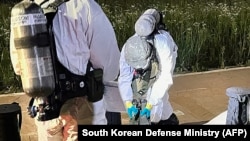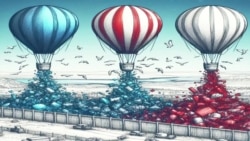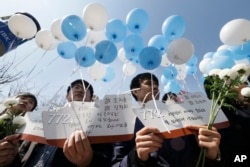North Korea’s deployment of hundreds of “trash balloons” over South Korea has underscored fears that rising tensions on the Korean Peninsula could boil over.
The purported cause of North Korea’s trash balloon campaign — retaliation for South Korean citizens’ deployment of balloons with leaflets critical of the regime of Kim Jong Un — is well-documented.
But Russian state media attempted to leverage media skepticism to mislead its viewers over Pyongyang’s actions, and Western reporting on them.
That is exemplified in an article from Sputnik Globe’s Moscow-based correspondent Ilya Tsukanov, titled “What Western Media Isn’t Telling You About North Korea’s Trash Balloon Campaign.”
“Slammed by Washington’s South Korean allies as a ‘nonsensical,’ ‘irrational’ and ‘low-class provocation,’ the Democratic People’s Republic of Korea’s declaration of a trash balloon war is really a response to South Korean propaganda balloon incitements that go back decades,” Tsukanov wrote.
That is misleading.
The “Western media” has broadly reported on South Korean activists’ deployment of balloons carrying bibles, medicine, thumb drives containing K-pop and K-dramas, and leaflets insulting North Korea’s leader.
The BBC, Associated Press, Vox, Bloomberg, New York Times, and many other mainstream outlets have provided explainers on the decades-long balloon drama.
Analysts speaking to media in South Korea have also questioned the effectiveness and motivations of the anti-Pyongyang campaign.
Tsukanov amplified North Korean allegations that the balloons from the South “can be utilized for a specific military purpose,” and repeated Pyongyang’s baseless allegation that Seoul could use them to spread “viruses.”
Sputnik said the “South Korean propaganda balloon incitements … go back decades,” and that “North Korea’s trash balloon warfare campaign is apparently a signal that Pyongyang has had enough and is no longer prepared to tolerate Seoul’s continued provocations without a response.”
That framing omits the fact that both sides have periodically engaged in this practice since the Korean War and that North Korea dispatched balloons filled with cigarette butts and messages insulting former South Korean President Park Geun-hye in 2016.
At that time, South Korea responded by resuming loudspeaker broadcasts near the border that included pop songs and criticism of the North Korean regime. Seoul has similarly considered resuming those broadcasts in response to the latest trash balloon campaign.
But unlike Pyongyang’s government-sponsored efforts to send trash-laden balloons southward, the South Korean government has not sent balloons for decades, although South Korean activists have.
Seoul’s tolerance of these activists has varied over time depending on North Korean actions. The balloon drama seemed to intensify following major escalations, like the sinking of the South Korean Navy ship ROKS Cheonan in March 2010, which an international investigation pinned on a North Korean missile.
In 2020, South Korea made the deployment of anti-Pyongyang leaflets a criminal offense punishable by imprisonment, but the country’s Supreme Court struck the law down on free speech grounds in December 2023.
Sputnik’s Tsukanov also repeats Pyongyang’s claim that its “trash balloon offensive is a tit-for-tat reaction to South Korea’s ‘provocative encroachment’ on the North's sovereignty, using everything from drills and spy drones to propaganda leafleting campaigns.”
While accusing the Western media of misreporting, Tsukanov omitted North Korea’s frequent saber-rattling. The Sputnik piece fails to mention Pyongyang’s repeated launch of ballistic missiles near the South Korean borders; efforts to launch military reconnaissance satellites in violation of United Nations Security Council resolutions; illegal nuclear weapons tests and simulated nuclear weapons strikes on South Korea; repeated GPS jamming campaigns that stretch back over a decade; and Pyongyang’s drone infiltrations.
Sputnik Globe’s report includes the fact that Kim Jong Un ordered the destruction of a South Korea-funded liaison office with Seoul in Kaesong in 2020 in response to southern activists sending lewd images over the border.
At that time, the BBC’s Seoul correspondent Laura Bicker said Pyongyang likely used the propaganda leaflet campaign as an “excuse” to blow up the building.
Bicker said Pyongyang's portrayal of the defectors participating in the balloon campaign as "scum" in state media reports after the building's destruction was intended to give North Koreans a “cause” to “rally around amid strict international sanctions and lack of economic prosperity."
The vast disparity between the life qualities in the two states also fuels Pyongyang’s growing belligerence, as traditional domestic propaganda has reportedly become ineffective.
“By the 1990s, it was clear that the North’s propaganda was losing its relevance as the South’s economy pulled ahead,” the New York Times reported on June 2.
“The South had become a vibrant democracy and a global export powerhouse, while the North suffered chronic food shortages and relied on a personality cult and a total information blackout to control its people,” the Times reported.
Having fallen so far behind its Southern neighbor, North Korea has renounced reunification efforts, analysts at the United States Institute of Peace, an American federal institution funded by the U.S. Congress, argued. This signals that Pyongyang now believes “a complete political and legal break from South Korea” is its “best survival strategy,” the report said.
Kim Jong Un called the K-pop and K-dramas South Koreans sent over the border on USB sticks a “vicious cancer,” underscoring the threat Seoul’s soft power posed to the isolationist “hermit kingdom.”
K-pop and K-dramas have grown into a global cultural phenomena, demonstrating Seoul’s democratic and economic advances and expanding the outside world’s knowledge about South Korea.
















